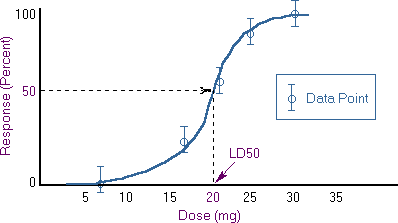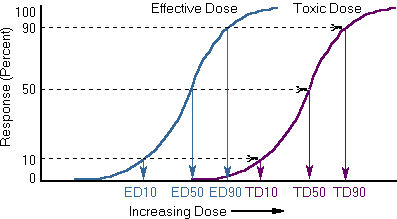|
 |
 |
 |
 |
|
|
|






Dose Estimates of Toxic Effects

Dose-response curves are used to derive dose estimates of chemical substances. A common dose estimate for acute toxicity is the LD50 (Lethal Dose 50%). This is a statistically derived dose at which 50% of the individuals will be expected to die. The figure below illustrates how an LD50 of 20 mg is derived.
Other dose estimates also may be used. LD0 represents the dose at which no individuals are expected to die. This is just below the threshold for lethality. LD10 refers to the dose at which 10% of the individuals will die.
For inhalation toxicity, air concentrations are used for exposure values. Thus, the LC50 is utilized which stands for Lethal Concentration 50%, the calculated concentration of a gas lethal to 50% of a group. Occasionally LC0 and LC10 are also used.
Effective Doses (EDs) are used to indicate the effectiveness of a substance. Normally, effective dose refers to a beneficial effect (relief of pain). It might also stand for a harmful effect (paralysis). Thus the specific endpoint must be indicated. The usual terms are:

Toxic Doses (TDs) are utilized to indicate doses that cause adverse toxic effects. The usual dose estimates are listed below:

The knowledge of the effective and toxic dose levels aides the toxicologist and clinician in determining the relative safety of pharmaceuticals. As shown above, two dose-response curves are presented for the same drug, one for effectiveness and the other for toxicity. In this case, a dose that is 50-75% effective does not cause toxicity whereas a 90% effective dose may result in a small amount of toxicity.

  
|
|
|
|




